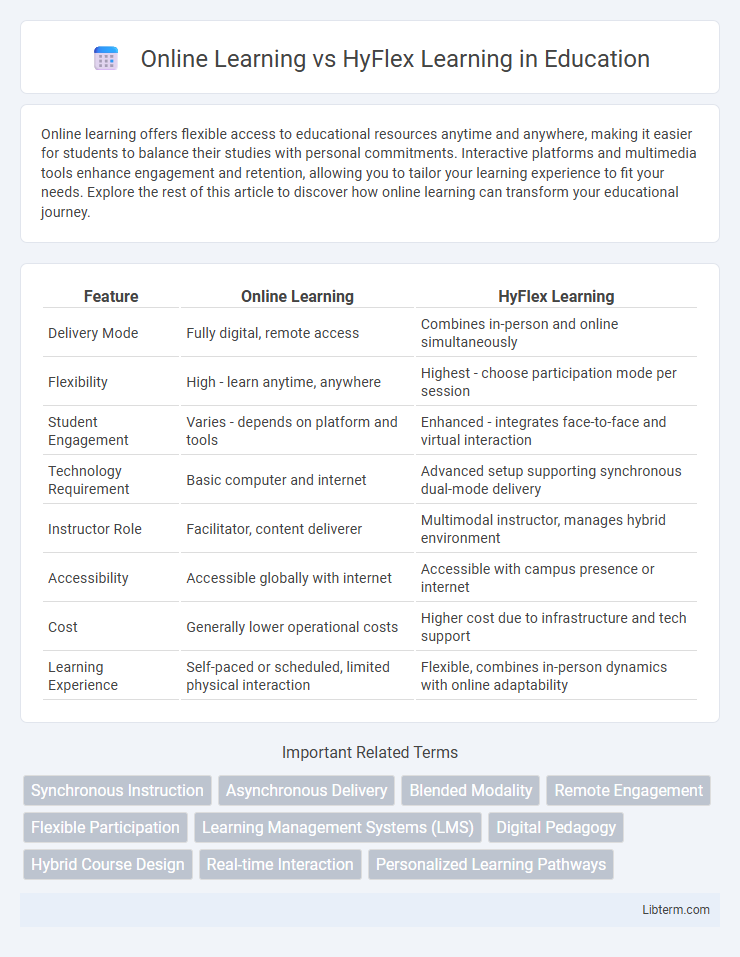Online learning offers flexible access to educational resources anytime and anywhere, making it easier for students to balance their studies with personal commitments. Interactive platforms and multimedia tools enhance engagement and retention, allowing you to tailor your learning experience to fit your needs. Explore the rest of this article to discover how online learning can transform your educational journey.
Table of Comparison
| Feature | Online Learning | HyFlex Learning |
|---|---|---|
| Delivery Mode | Fully digital, remote access | Combines in-person and online simultaneously |
| Flexibility | High - learn anytime, anywhere | Highest - choose participation mode per session |
| Student Engagement | Varies - depends on platform and tools | Enhanced - integrates face-to-face and virtual interaction |
| Technology Requirement | Basic computer and internet | Advanced setup supporting synchronous dual-mode delivery |
| Instructor Role | Facilitator, content deliverer | Multimodal instructor, manages hybrid environment |
| Accessibility | Accessible globally with internet | Accessible with campus presence or internet |
| Cost | Generally lower operational costs | Higher cost due to infrastructure and tech support |
| Learning Experience | Self-paced or scheduled, limited physical interaction | Flexible, combines in-person dynamics with online adaptability |
Introduction to Online Learning and HyFlex Learning
Online learning delivers educational content entirely through digital platforms, enabling students to access lectures, assignments, and resources remotely at their own pace. HyFlex learning combines online and face-to-face instruction, allowing learners to choose between attending classes in person or synchronously online, promoting flexibility and accessibility. Both models leverage technology to enhance engagement but differ in structure, with HyFlex offering a blended experience tailored to diverse student needs.
Key Features of Online Learning
Online learning offers flexibility by allowing students to access course materials anytime and anywhere, supporting asynchronous study schedules. It leverages digital platforms for lectures, assessments, and communication, enabling a fully virtual learning environment without the need for physical presence. Key features include multimedia content delivery, interactive forums, and automated grading systems designed to enhance engagement and accommodate diverse learning paces.
Core Characteristics of HyFlex Learning
HyFlex learning integrates both in-person and online modalities, offering students the flexibility to choose between attending face-to-face sessions or participating virtually at their convenience. It emphasizes student autonomy, allowing learners to switch between modes without sacrificing access to course materials or engagement quality. Core characteristics include simultaneous delivery of content, adaptive technology use, and equitable learning experiences across diverse participation methods.
Accessibility and Flexibility Compared
Online learning offers unparalleled accessibility by enabling students to participate from any location with internet access, eliminating geographical barriers and allowing for asynchronous study. HyFlex learning combines the benefits of both in-person and online formats, providing students with flexibility to choose their mode of participation--either attending face-to-face sessions or joining virtually in real-time. This dual modality enhances inclusivity by accommodating diverse learning preferences and schedules, optimizing engagement and retention.
Student Engagement in Online vs HyFlex Models
Student engagement in HyFlex learning models tends to be higher compared to purely online learning due to the flexibility of attending sessions either in-person or virtually, which caters to diverse learning preferences. HyFlex environments promote active participation through real-time interactions, immediate feedback, and collaborative activities, enhancing motivation and connection among students. In contrast, online learning often struggles with sustaining engagement due to factors like screen fatigue and limited spontaneous peer interaction, although well-designed online platforms can mitigate some of these challenges.
Technology Requirements and Challenges
Online learning demands reliable high-speed internet, compatible devices like laptops or tablets, and user-friendly platforms to facilitate seamless virtual interactions. HyFlex learning requires more advanced technological infrastructure, including synchronous video conferencing tools, interactive software, and robust classroom hardware to support simultaneous in-person and remote participation. Both modalities face challenges related to digital equity, technical support, and maintaining engagement across diverse learning environments.
Instructor Roles and Adaptation
In online learning environments, instructors primarily facilitate digital content delivery, engage students through virtual discussions, and utilize learning management systems to monitor progress and provide timely feedback. HyFlex learning demands instructors adapt by designing courses that seamlessly integrate both in-person and online modalities, requiring enhanced technological proficiency and real-time multitasking to meet diverse student participation preferences. Effective adaptation in HyFlex settings hinges on instructors' ability to balance synchronous and asynchronous teaching, ensuring equitable access and engagement for all learners regardless of their chosen mode.
Impact on Collaboration and Community
Online learning often limits spontaneous interactions and peer collaboration due to its reliance on virtual communication platforms, which can lead to feelings of isolation among students. HyFlex learning, combining in-person and online modalities, facilitates dynamic collaboration by allowing students to choose their mode of participation, thus enhancing community engagement and inclusivity. Studies show that HyFlex environments improve social presence and collaborative learning outcomes compared to fully online settings.
Outcomes and Academic Performance
Studies show that HyFlex learning models, which combine in-person and online instruction, often result in higher student engagement and improved academic performance compared to fully online learning. Academic outcomes in HyFlex courses tend to benefit from increased flexibility, enabling personalized learning paths that accommodate diverse student needs and learning preferences. Data from institutions implementing HyFlex indicate that retention rates and grade point averages frequently surpass those observed in exclusively online learning environments.
Choosing the Right Model: Factors to Consider
Choosing the right learning model requires evaluating factors such as student engagement, technological access, and instructional flexibility. Online learning offers convenience and broad accessibility, ideal for remote or self-paced study, while HyFlex learning combines in-person and online modalities to accommodate diverse learner preferences and schedules. Consider institutional resources, course objectives, and student demographics to determine which approach maximizes educational outcomes.
Online Learning Infographic

 libterm.com
libterm.com